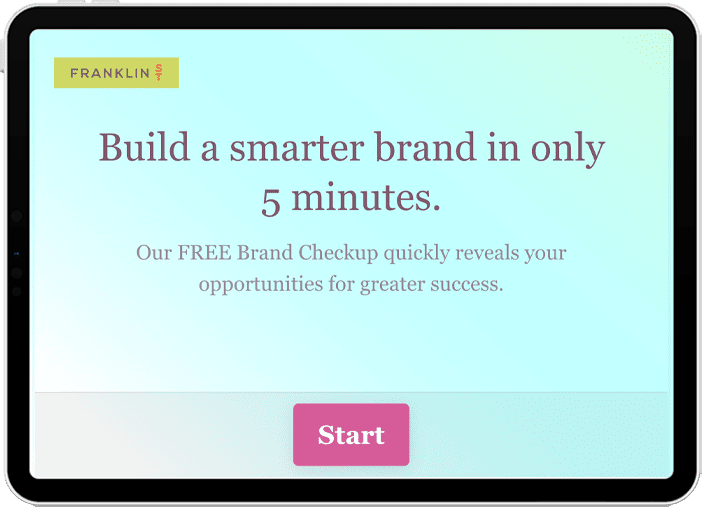We publish this annual report to help our clients and colleagues gain a foothold in the trends, changes and opportunities that will shape the coming year. In this report, you’ll learn about trends that have powerful implications for health systems and marketers.

For 30 years, Franklin Street has built patient-centered brands® for health systems across the country. Our branding, strategic marketing and digital solutions achieve preferred brand status, grow market share and win over the toughest internal stakeholders.
RADICAL CONVENIENCE

What do today’s patients want? It’s simple: everything. And they want it now.
Technology has sped up the pace of change and how long we’re willing to wait for what we want. Services like Uber and Amazon’s same day delivery are stoking the fires of consumer wants by over-delivering on convenience. Your brand will feel ancient if patients can’t get lab results in a few hours or they can’t book an appointment from their phone. As a health care marketer, you might not have direct impact on how fast patients can be treated in the ER but you might have leverage on how easy it is for patients to book their spot in the ER (or book a mammogram, for that matter). Patients may trust your brand to deliver quality care, but they want that care delivered with radical convenience.
Questions to Start Applying the Trend
- What 3rd party tools can you leverage to make it easier for consumers to book appointments?
- Are you maximizing your system’s EMR to give patients easy access to test results and other health information?
- Is your call center making it easy for patients and prospective patients to access the care and resources they want and need?
- Does your competition outpace you on ease of access and “radical convenience?” If so, what will you do to close the gap?
Why Your Patients Are Going to Tijuana for Health Care
We profiled the rise of commercially-insured patients leaving the country for medical care based on radical convenience. Read and learn about new health care consumers who are changing the rules.
Read more here.
EVERYTHING IS A PROTOTYPE

The line between concept and “final” campaign is now very blurry. And that’s a very good thing.
Thanks to digital channels, health care marketers can now get real-time feedback from prospective patients on which headlines, images, offers and landing pages generate more demand and conversions. This gives marketers the power to iterate—with the opportunity to make each new version of the campaign perform better than the last. But the power of prototyping doesn’t just reside at the messaging level. Now health care marketers are using the power of prototyping during the development of the marketing strategy. Instead of committing to strategies based on what the “market should want,” marketers are letting the audience guide the services, product offerings—and campaign message.
Questions to Start Applying the Trend
- What services or offerings is your organization planning to bring to the market and how could you share prototypes with audiences for feedback?
- How could you encourage your team or agency to conduct rapid-style prototyping and test multiple ideas before committing to a final direction?
- How might you build in feedback loops on your current campaigns to evaluate real-time engagement and conversions?
The Guide for Testing Digital Campaigns
If you’re not convinced you’re testing and measuring the right campaign attributes, may we suggest reading our guide to testing digital campaigns?
Read more here.
MAKE STORIES THAT MATTER

Technology and awards are the stuff of press releases. Humans healing humans is the stuff of stories that matter to your consumers.
Health care consumers expect providers to have technology, quality medical care and awards. But unfortunately, they don’t expect all providers to have a heart. That’s why health care marketers are finding and sharing the stories that make their communities proud. The best health systems don’t just tell compelling stories, they make their own. They are finding patients who need something and documenting how they deliver that need with poignant storytelling. In the ultimate service industry, emotion matters more in health care than anywhere else.
Questions to Start Applying the Trend
- What are the “hallway moments” in your organization that you can share—the small but meaningful gestures that employees do to make a difference in a patient’s life?
- How can you share these stories in owned media vehicles like Facebook, YouTube channels and blogs?
- How could you create a repository for employees to contribute “magic moments” to keep a well-stocked supply of stories to share?
Ways to Get Better Real Moments on Camera
Read eight of our best tips for capturing great moments on camera—with patients, doctors and employees.
Read more here.
THE 99 PERCENTERS

Successful marketing campaigns might convert 1% of the audience into patients. But really successful campaigns keep nurturing the 99% of audience who aren’t ready to buy—yet.
Health care marketers are leveraging what they’ve known intuitively for years: health care is a complex decision-making process. For many service lines, the lag between interest to patient encounter might be two to three years (or longer). That’s why marketers are investing at higher rates than ever in tools like marketing automation and content marketing. These tools build a relationship with prospective patients, nurturing them with resources to help them make informed choices—with the promise of future patient encounters. Instead of measuring success in 30-day increments, health systems are waking up to the need to look at the long-term value of marketing and communications.
Questions to Start Applying the Trend
- What tools do you have for building and growing your list of names and emails for sending relevant content to those not quite ready to become patients?
- How can you repurpose existing content and share with these audiences?
- What are the Frequently Asked Questions among prospective patients for your top services and how can you help answer those questions with your content?
- How can you get service line leaders to be more engaged with a longer buying cycle?
How to Get 775 New Patients in 90 Days
On our site, we share the playbook for driving new patients and creating long-term lead nurturing for the 99 percent of the population not ready to become a patient.
Read more here.
ADDICTION IS THE NEW CANCER

The Surgeon General’s report on addiction is a call to arms to every health system in the nation.
20 million Americans battle addiction. Injuries from drug overdose is the leading cause of injury death in the U.S., ahead of motor vehicle deaths and firearms. And the heroin epidemic is shattering records as it decimates whole generations—along with the potential their lives may have brought us. That’s why the Surgeon General has identified addiction as “a bigger health problem than cancer.” It’s in our cities, our suburbs, our farms and our living rooms. This is a call to arms for every health system in the nation. Your brand cannot be patient-centered or trusted by our desperate communities if your system is not in this fight.
This fight is here. Get ready.
Questions to Start Applying the Trend
- If you are asked by the media or community leaders what you are doing about the epidemic, what will you say?
- Is this on your C-Suite’s radar? What plans are in place or coming? How can you help?
- What operational impact (specifically in your ED) is addiction having already? How can you help?
- Addicted associates have decimated the reputation of many systems. How are you addressing this epidemic internally? Does your staff know where to get help?
- Are there inspiring brand stories to tell? Your brand may already be making a difference in this fight. Share your stories.
Addiction: A Primer for Hospital Marketers
Visit this powerful website: cover2.org. We’ve met its founder, Greg, and his story will change the way you think about addiction.
Download the Surgeon General’s Report here.
We hope the 2017 Health Care Marketing Trends Report inspires you to take action.
Here are ideas on what you can do next.
- Host a brainstorm with your team and identify 5-10 actions you can take based on the trends.
- Lead a discussion with organization leaders about the trends and what the organization might do to leverage them.
- Share the report with colleagues outside your organization and discover what new ideas and insights come forth.
Franklin Street’s reports are used by health systems and providers all over the country. Our thought leadership and best practices are read and applied by tens of thousands of health care marketing professionals around the world.
If you’re not already on our monthly publication list, visit franklinstreet.com and look for the invite to join our community.
You can also email Megan Walworth at mwalworth@franklinstreet.com, and we’ll add you to the growing community.

